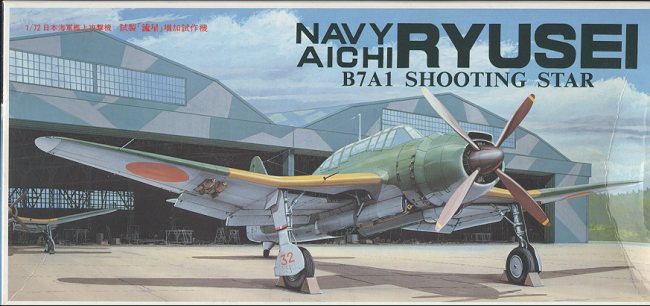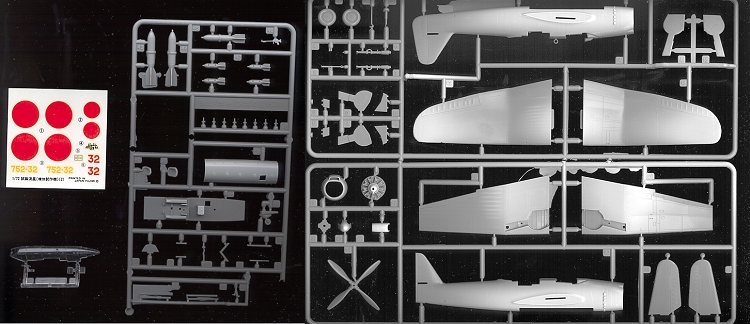
|
KIT: |
Fujimi 1/72 B7A1 Ryusei 'Grace' |
|
KIT # |
7AF1 |
|
PRICE: |
@$20.00 |
|
DECALS: |
One aircraft |
|
REVIEW & |
|
|
NOTES: |
Currently unavailable (July 2000) |

|
HISTORY |
Probably the largest carrier-borne aircraft to be developed for Japanese navy, the Aichi B7A Ryusei (Shooting Star) was designed to replace both the Nakajima B6N 'Jill' and Yokosuka D4Y 'Judy'. It was to operate from a new class of larger aircraft carriers so the typical 36 foot length restriction was waived. It was required to carry a payload of 800kg 1,000 nautical miles at a maximum speed of 300 knots (354mph), and to be as maneuverable as the A6M Zero fighter. (!) Quite a requirement.
The result was a very large aircraft with an equally large and powerful 18 cylinder Nakajima Homare engine that produced between 1,800 and 2,200 hp. Despite constant problems with the engine, the B7A not only met, but exceeded all requirements. It was then placed into production albeit with production rates being quite slow. After only 114 aircraft had been built, Aichi's Funataka plant where the aircraft was being built was destroyed by an earthquake in May of 1945. Actually, this had little impact in the overall war effort as there were no longer any aircraft carriers on which to put the Ryusei. Those that did see limited service were flown from land bases with the Yokosuka and 752nd Kokutais.
|
THE KIT |

The kit is in the typical medium grey plastic so beloved by most Japanese kit makers. It has fine engraved detailing, no ejector pin marks in visible locations, and no sink marks. It does have some flash as you can see, but cleanup shouldn't be a problem. Cockpit detail is adequate but not spectacular as there is no sidewall detail and just minimum parts for the inside. Options are for gear up as well as small bombs on the wings. The bomb bay can be built in the open position and there are two bomb options for the inside of the bomb bay. There is some detail in the wheel wells and the landing gear are well done and scale. The transparency is very crisply molded and thin.
The instruction sheet contains 7 construction steps, noting any needed colors in each step. The construction steps are very clear and concise. Again, there is only one choice for markings, however, since the aircraft only flew with two Kokutais, this isn't a major problem as it is with other Fujimi kits. The decals are thick but do fit well and will snuggle down. I would not recommend using any setting solution on them as they may permanently wrinkle!
Overall it is a relatively simple build. There are, to my knowledge, no aftermarket parts of any kind for this kit so you are on your own when it comes to extra detailing. It is a bit more complex that some other Fujimi kits so I would not recommend this to the bare beginner. Other skill levels should have no problems with it and it will make into a fairly large aircraft.
|
REFERENCES |
Japanese Aircraft of the Pacific War by Rene J Francillon, Putnam, 1979
Review copy courtesy of me and my wallet!
If you would like your product reviewed fairly and quickly by a site that has over 1,000 visits a day, please contact me or see other details in the Note to Contributors.